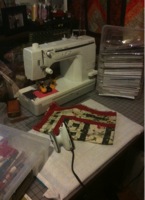From – January 11, 2010
My sewing space, no matter how large or small over the years, had to be the site of at least some storage. Nature abhors a vacuum and it never seems as true as in a sewing room. My storage needed to be arranged so that those items that I used least were most distant and more difficult to get to. The stuff that I reached for more often, should have been within arm’s length.
This kind of storage solution was a very difficult accomplishment for it sometimes came at the expense of the actual sewing space. When there are pin cushions and scraps and pieces of my project and scissors and seam rippers and bobbins and rulers and a rotary cutter and the extra light source and and and on my table, I had less room for fabric movement and sewing, even though all of my tools were seemingly easily accessible.
So the goal is to have those tools that I needed as I sewed readily available to me, within reach but off of my sewing surface. I have been struggling with what to do with my rulers for some time. I have purchased racks and hangers but I haven’t found a good solution. The next thing to try is a plant hanger and S hooks, hung to the side and above my cutting table. Drawers with dividers can be a good solution for all of the small stuff and there is an awful lot of small stuff to keep track of. Whether I used baskets or drawers, hooks or files, tools are only worthwhile if they are accessible.
So there is a small container on the sewing surface that acts like a pencil holder for my cutting tools (rotary cutters of various sizes, scissors of various sizes). There are a couple of bobbin holders that keep the bobbins and the subsequent thread they hold in a neat space without stray strands tangling with anything else it can reach. And there is an additional light source, all taking up precious sewing area.
My sewing machine sits on a table that is covered by a cutting mat, 58” x 33” so I don’t need extra cutting space, and I just shove the machine back to cut, trim or adjust. I do have a small ironing mat to the left of the machine for ironing seams. That means that a small iron also has to sit on the sewing surface, which means less sewing space. These are the gives and takes.
Thread storage also has to be considered. My embroidery thread is separated and warehoused by color in plastic containers sold by the manufacturer. That leaves the cotton for quilting. When the thread is easily found and available in my sewing room, I am much less likely to buy duplicates. I have plastic thread containers for the cotton as well but they are admittedly, much less organized and thread does tent to wander. The cotton thread containers are also larger and don’t fit as easily onto the designated thread space on the shelves. I will have to rearrange things so that all of my thread has a permanent home address in my room.
The subject of where to house my books and patterns is almost as large as the collection itself and will have to be addressed later.
Places like the Container Store, Target and even the 99 cent store have loads of containers, files, baskets and whatever. Organizing and stowing all of the little things that I need to create can be an energizing and creative process in and of itself. Coordinating all of my storage tools and blending them into my overall sewing room design is fun.
Having said that, let me give warning, be careful of organizational devices. They take up space as well. If they improve the work area by making tools and materials safe, organized and handy, use them. However, organizational devices can also function as more clutter. More is not always better and they cannot ultimately solve the problem of simply too much stuff. It was a metanoia to me when I came to the conclusion that 900 cubic feet of stuff just would never fit into 800 cubic feet of space, no matter how organized it was.
Lastly, storage and organization is to augment and make my sewing space more convenient. It is not the purpose of my room. The purpose of my sewing room is actually to have a place where I can go to create and sew. If the storage aspect of my room takes over the area that I need for doing the real work, then I have missed the goal.
My work is the primary focus and the support in accomplishing that objective is secondary. When the stuff and its organization make take over the room and I don’t have the space to sew, something has gone terribly wrong and must be fixed. I will either have to pare down what I am storing or I will have to find other space for the excess stuff. I do need to keep in mind that the further and more obscure the places I put things the less useable those things are. Should I create additional storage or should I cull the excess?
What I do want is to be able to go into my sewing room and let my creativity flow in an area that fosters those juices.
Click here to Join Us in the Online Quilting Classes Community!
Karen Dennison
Learn, Grow, Share – And most of all – Create!



